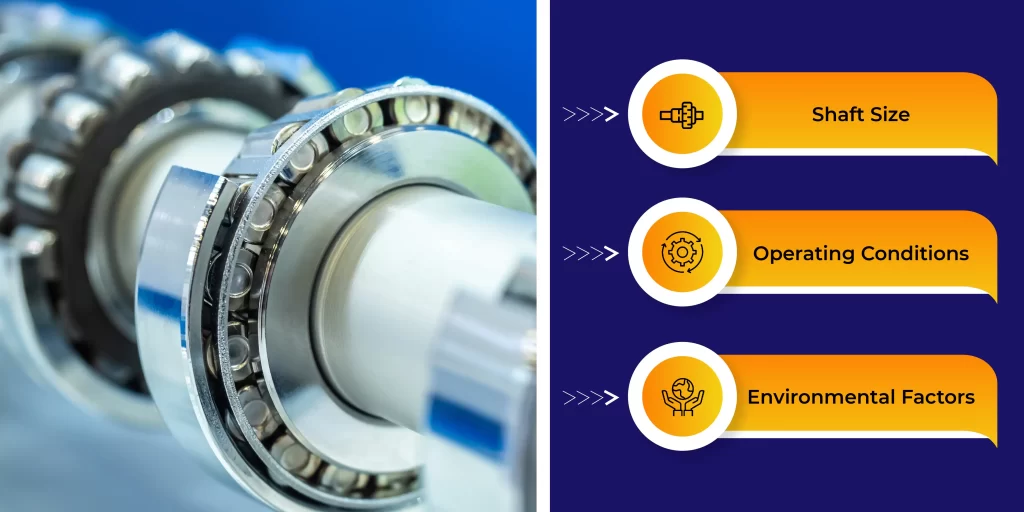A ball bearing is a type of rolling element that uses balls to reduce friction by maintaining the separation between the moving parts and guiding it. The function of a ball bearing is to reduce friction, support loads, and guide or support the rotating parts in the machinery. The efficiency of ball bearings can be determined by their widespread usage in various industries such as automotive, manufacturing, home appliances, aerospace, and many other industries.
The machines usually function in a high-stress environment and at very high rotational speed to support rotating components and maintain operational efficiency.
In industries where machinery operates at extremely high speed, like automotive, and aerospace, the rotational speed of ball bearing is crucial as it directly affects the overall performance.
The speed rating of the ball bearing is a measure that determines/indicates the maximum speed limit at which the bearing can rotate safely without getting too hot or wearing out. The speed rating of the ball bearing is measured in revolutions per minute (RPM). The importance of speed rating in ball bearings,
- Efficiency: Different machines and industries have varied speed requirements. Selecting the right bearing as per the speed rating ensures the overall efficiency of the machinery.
- Reliability: Ball bearings in machines that usually function in a high-speed environment are more prone to wearing out early, but staying within the speed rating ensures longer bearing life and reliability.
- Prevention: Staying within the maximum speed at which the bearing can rotate prevents the bearing from overheating.
RPM (Revolutions Per Minute) - Standard Unit for Speed Ratings
Revolutions per minute (RPM) is the unit used to measure the speed at which the bearing rotates. The speed rating of a bearing is measured in RPM. It measures the number of times the bearing spins/rotates across its axis in a minute.
Types of Speed Ratings
- Limiting Speed Ratings: The highest revolutions per minute (RPM) at which a bearing can function safely and sustain minimal wear for shorter periods.
- Reference Speed Rating: A bearing’s reference speed is the speed at which it can function continuously for longer periods without overheating, wear or damage.
Factors Affecting Speed Ratings

Several factors affect the speed rating of bearings, including:
- Bearing Design: Although most bearings are designed to handle speed, certain bearing designs have higher speed ratings, ball bearings usually have higher speed ratings than roller bearings.
- Lubrication: Lubrication helps reduce the friction between the bearing components and significantly affects the speed rating. Oil-lubricated bearing usually has a higher limiting speed compared to grease-lubricated bearing.
- Load: Bearings are designed to handle the load, but with heavy load more friction and heating get generated and result in premature failure, load must be considered based on speed rating, usually bearings designed for lighter weights rotate/spin faster.
- Temperature: Bearings generate heat, especially at high speed, the speed rating is often tied to how well the bearing can manage the heat.
- Material and Quality: The material & quality of the bearing affect the speed rating significantly as these factors determine how the bearing performs under high-speed operations.
How to Determine the Right Speed Rating?
The speed rating of a bearing indicates the maximum speed at which the bearing can operate safely, without overheating and ensuring a longer bearing life. Determining the right speed is an important factor that affects the overall efficiency of the system. There are various factors to determine the right speed of a ball bearing including,
Application Requirements: There is no one size fits all methodology, when it comes to deciding the right speed rating for the application requirement. It involves assessing the various factors related to the machine’s operational conditions including,
- Determine the Required Operating Speed: Check for the maximum revolutions per minute (RPM) required and select the bearing that has a speed rating of at least the maximum speed or greater than the required RPM.
- Load Requirement: Identify the load required as it affects how a bearing performs. Usually with higher loads the bearing can perform at maximum speed, while with heavy loads bearing with a lower speed rating is required.
Manufacturer Specifications: These are detailed data and documents provided by the bearing manufacturer on bearing specifications related to speed rating, bearing material, and load capacity. This detailed data includes specifications like,
- Limiting Speed: The highest revolutions per minute (RPM) at which a bearing can function safely and sustain minimal wear for shorter periods.
- Reference Speed: A bearing’s reference speed is the speed at which it can function continuously for longer periods without overheating, wear or damage.
- Load Ratings: The maximum load a bearing can support while operating at its peak speed.
- Bearing Material: Information on the bearings components such as stainless steel ceramic chrome steel etc.
- Lubrication: The type of recommended lubrication such as oil, grease or self-lubrication as well as the lubrication frequency.
- Temperature Range: This includes information related to the range of temperature that the bearing can work without getting damaged.
Common Issues and Solutions
Overheating:
Overheating issues often affect the bearing’s lifespan and overall performance of the system/machinery. In high-speed applications friction between the bearings is extreme and causes overheating and thermal expansion. Overheating of the bearings can even occur with bearings with high-speed ratings due to improper usage, operating conditions, etc. High-speed rated bearings frequently overheat due to improper alignment or installation, excessive load, inadequate lubrication, etc.
Preventing overheating in high-speed rated bearings involves,
- Optimising Lubrication
- Ensuring Proper Installation
- Managing Load Conditions
- Maintaining Suitable Operating Conditions
- Monitoring Bearing Performance Regularly
Vibration and Noise:

Noise and vibration even with high-speed rated bearings are major problems in high-speed applications. The efficiency of the system as a whole may be impacted by vibration and noise since they can increase friction and energy loss. Common causes include overloading poor lubrication contamination worn-out or defective parts etc.
The solution to minimise vibration and noise in high-speed applications:
- Proper Installment & Alignment
- Regular Maintenance
- Proper Lubrication
- Minimise Contamination
Wear and Tear: High-speed applications typically function in demanding and stressful environments and the high rotational speed causes bearings to endure constant stress. Constant high-speed rotation, heavy load, and other environmental conditions start to impact the overall performance of bearing by wear and tear. Among the frequent reasons for premature wear and tear are overload contamination and inadequate lubrication. Proper lubrication, regular maintenance, and protection against contamination are some of the preventive measures that help with premature failure of bearing due to wear and tear.
Industry Applications of High-Speed Bearings
|
Industry |
Applications |
|
Aerospace |
Gas turbines, jet engines, helicopter transmission |
|
Automotive |
High-speed gearbox, transmission, turbochargers |
|
Industrial Machines |
High-speed compressors, turbines, industrial fans |
|
Energy/Power Generation |
Wind turbines, hydroelectric systems |
Future Trends: Predictions and trends for the future of High-speed Ball Bearings:
The popularity of ball bearings can be determined by their widespread usage in various industries such as automotive, manufacturing, home appliances, aerospace, and many other industries. Considering the rapid growth/expansion of various industries like robotics and automation, electric vehicles, renewable energy, space exploration satellites, etc necessitates the increased need for high-speed ball bearings. The growing popularity of smart technology, the growing need for ball bearings in healthcare, and the rising demand for automation in the manufacturing sector are all signs of a high-demanding future for the high-speed bearing industry.
FAQ's
How fast can ball bearings go?
The rotational speed of ball bearings depends on the bearing design and application. The speed of the ball bearing can be measured in revolutions per minute (RPM).
What is the reference speed of a ball bearing?
A bearing’s reference speed is the speed at which it can function continuously for longer periods without overheating, wear or damage.
Do bearings have speed limits?
Yes, bearings have speed limits. It indicates the highest speed at which the bearing can operate. These limits ensure the bearing operates efficiently and reliably.
How do you calculate bearing speed?
The speed at which the bearing rotates is measured in revolutions per minute (RPM). Revolutions per minute measure the number of times the bearing rotates/spins across its axis in a minute.










